Welcome to “Pedal Perfection: The Ultimate Guide to Bicycling”! Whether you’re a seasoned cyclist or a beginner just starting out, this guide is packed with valuable insights to help you master the art of cycling. From proper bike fit and pedal stroke techniques to choosing the right gear and ensuring safety on the road, we’ve got you covered.
At its core, bicycling is about more than just the activity itself—it’s a lifestyle, a passion, and a form of exercise that grants you the freedom of the open road. Bicycling allows you to fully immerse yourself in the wonders of nature, explore new biking trails, and connect with a vibrant community of bicycle enthusiasts. So, strap on your helmet, clip in, and let’s dive into the world of pedal power!
Key Takeaways: Bicycling
- Mastering the art of pedaling is crucial for efficient and effective cycling.
- A proper bike fit, including saddle height and alignment, plays a vital role in optimizing your pedal stroke.
- The pedal stroke consists of four zones, each requiring different muscle engagement and technique.
- Avoid common mistakes in the pedal stroke, such as relying too much on the downstroke phase.
- Mastering the perfect pedal stroke leads to enhanced efficiency, power output, endurance, and injury prevention.
The Importance of a Proper Bike Fit
A solid bike fit is crucial for a smooth and powerful pedal stroke. When it comes to cycling, your bike should feel like an extension of your body, allowing you to ride with maximum comfort and efficiency. This is where bike fit comes into play, ensuring that your bike is properly adjusted to your unique body proportions and biomechanics.
One of the key elements of a proper bike fit is saddle height. The correct saddle height is essential for optimal pedaling efficiency. If your saddle is too high, you may experience excessive strain on your knees, leading to knee pain and potential injury. On the other hand, if your saddle is too low, it can limit your power output and hinder your ability to generate force through the pedals.
In addition to saddle height, proper alignment of the bike’s components is crucial. This includes ensuring that your handlebars, pedals, and cleats are all positioned correctly. Proper alignment allows for efficient power transfer from your legs to the pedals, enabling you to generate more power with each pedal stroke.
If you’re experiencing knee pain or discomfort while cycling, it could be a sign that your bike fit needs adjustment. A bike fit specialist can help you determine the proper position for your saddle and make adjustments to ensure proper hip-knee-ankle alignment throughout the pedal stroke. This will not only alleviate discomfort but also improve your overall pedaling efficiency.
“A solid bike fit can make a world of difference in your cycling experience. It can enhance your comfort, prevent injuries, and optimize your performance on the bike.” – Bike Fit Specialist, James Anderson
By investing in a proper bike fit, you can optimize your cycling experience and unlock your true potential on the bike. You’ll be able to ride longer, pedal more efficiently, and avoid unnecessary injuries. So, if you haven’t had a bike fit yet, it’s time to consider scheduling one and experiencing the benefits firsthand.
Common Signs of an Improper Bike Fit
| Signs of an Improper Bike Fit | Possible Causes |
|---|---|
| Knee pain | Saddle height too high or too low |
| Lower back pain | Incorrect saddle tilt or handlebar position |
| Numbness or tingling in hands | Handlebar position too low or too far forward |
| Foot numbness or hot spots | Incorrect shoe cleat positioning |
Mastering the Perfect Pedal Stroke
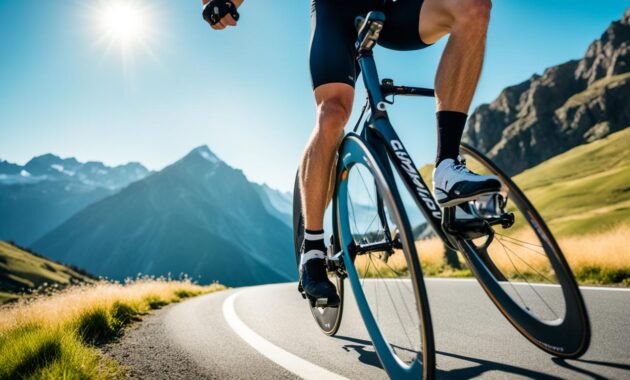
Now that you have achieved a proper bike fit, it’s time to focus on mastering the perfect pedal stroke. The pedal stroke is composed of four distinct phases, each requiring specific muscle engagement and technique. By understanding and refining these phases, you can significantly enhance your cycling performance.
The Four Phases of the Pedal Stroke
- The Power Phase: This is the phase where you generate the most power and transfer it to the pedals. It involves pushing down on the pedals with force using your quads and glutes. The power phase allows you to propel the bike forward and gain momentum.
- The Transition Phase: After the power phase, there is a brief moment of transition where you smoothly transfer the force from the downstroke to the upstroke. It requires a seamless transition of muscle engagement and coordination.
- The Upstroke Phase: In this phase, you pull the pedal upward using your hamstring and hip flexor muscles. While it may seem counterintuitive, pulling up on the pedal helps to maintain an even cadence and increase the efficiency of your pedal stroke.
- The Downstroke Phase: The downstroke phase is where you apply pressure to the pedals while pushing them down. This phase predominantly engages your quads and glutes, acting as the primary power generator.
To master the perfect pedal stroke, it is crucial to pay attention to each of these phases and focus on optimizing muscle activity. One technique that can significantly improve your pedal stroke is the ankling technique, where you point your toes down at the bottom of the stroke and flex your ankle. This technique adds efficiency and power to your pedal stroke, enhancing your overall performance.
In addition to the ankling technique, maintaining an optimal cadence is key to a powerful pedal stroke. Cadence refers to the number of pedal revolutions per minute (RPM). Finding your ideal cadence depends on various factors, including terrain and personal preference. Experimenting with different cadences during training rides can help you discover what works best for you. Aim for a cadence that allows you to maintain a smooth and controlled pedal stroke while generating power consistently.
By optimizing your muscle engagement, employing the ankling technique, and maintaining an ideal cadence, you can increase your power output and improve overall cycling performance. Mastering the perfect pedal stroke takes time and practice, but the results are well worth the effort.
Benefits of Mastering the Perfect Pedal Stroke
| Benefits | Description |
|---|---|
| Improved Power Output | Efficient muscle engagement and technique maximize power transfer to the pedals. |
| Enhanced Efficiency | A smooth and controlled pedal stroke reduces energy wastage and improves overall efficiency. |
| Increased Endurance | Optimizing muscle activity reduces fatigue, allowing you to ride longer distances with ease. |
| Reduced Risk of Injury | Proper muscle engagement decreases stress on joints and muscles, minimizing the risk of injury. |
Common Mistakes in the Pedal Stroke
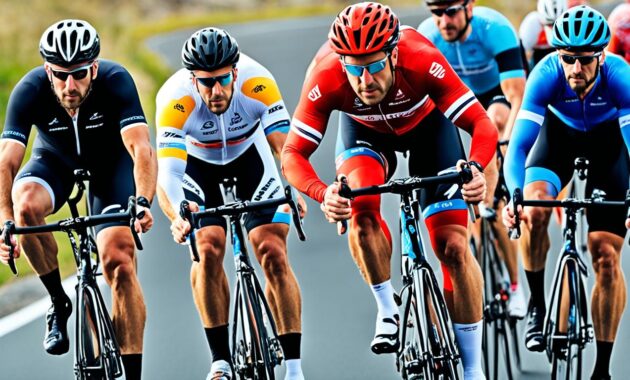
When it comes to perfecting your pedal stroke, avoiding common mistakes is key to improving efficiency, preventing fatigue, and reducing the risk of injury. Many cyclists unknowingly make these mistakes, compromising their performance and overall riding experience. By identifying and correcting these errors, you can minimize energy wastage, increase efficiency, and improve your cycling abilities.
1. Overemphasizing the Downstroke Phase
One common mistake in the pedal stroke is relying too heavily on the downstroke phase while neglecting the other phases. While the downstroke generates power, focusing solely on this phase can lead to decreased efficiency and energy wastage. It’s important to distribute the workload evenly throughout all four phases of the pedal stroke to optimize muscle engagement and power output.
2. Neglecting Transitions and Bouncing on the Saddle
Smooth transitions between different phases of the pedal stroke are crucial for maintaining a constant and efficient cadence. Neglecting these transitions, especially in the bottom part of the stroke, can disrupt the flow and waste energy. Additionally, bouncing or excessive movement on the saddle can result in decreased efficiency and increased fatigue. Maintaining stability and minimizing unnecessary movements can greatly improve your pedal stroke.
3. Improper Technique and Alignment
Executing the pedal stroke with proper technique and alignment is essential for optimal performance and injury prevention. Incorrect foot placement or ankle movement can lead to decreased efficiency, fatigue, and potential injuries. It’s important to maintain a neutral foot position, engage the correct muscles, and ensure proper alignment of the hip, knee, and ankle throughout the entire pedal stroke.
“Identifying and correcting these mistakes is essential for improving pedal stroke efficiency and reducing the risk of injury.”
By addressing these common pedal stroke mistakes, you can significantly enhance your cycling abilities. Not only will you reduce energy wastage and improve efficiency, but you will also experience reduced fatigue and a decreased risk of injury. To visually understand the impact of these mistakes and the correct technique, refer to the following table:
| Mistake | Effect | Correction |
|---|---|---|
| Relying too much on the downstroke phase | Energy wastage, decreased efficiency | Distribute workload evenly across all phases |
| Neglecting transitions and bouncing on the saddle | Energy wastage, decreased efficiency, increased fatigue | Ensure smooth transitions and minimize unnecessary movements |
| Improper technique and alignment | Decreased efficiency, potential injury | Maintain proper foot position, engage correct muscles, and ensure alignment |
Correcting these mistakes requires awareness, practice, and potentially working with a cycling coach or experienced rider. By prioritizing proper technique and employing the correct muscle engagement, you can significantly enhance your pedal stroke efficiency, increase power output, and enjoy a smoother, more enjoyable ride.
Continue to the next section to discover the benefits of a perfect pedal stroke and how it can elevate your cycling performance.
Benefits of a Perfect Pedal Stroke
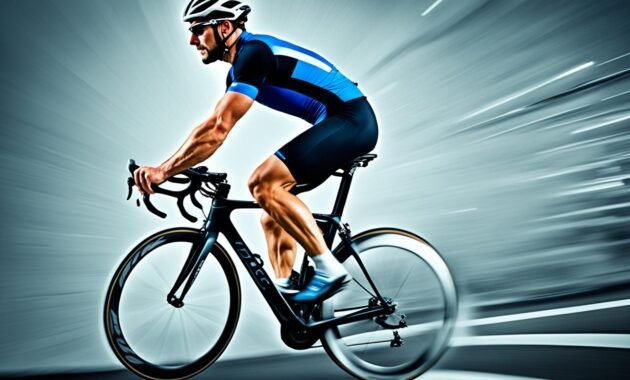
Mastering the perfect pedal stroke offers numerous benefits. By achieving a smooth and efficient pedaling motion, you can unlock your cycling potential and enhance your overall performance.
Increased Efficiency
A perfect pedal stroke allows you to maximize the power you generate with each revolution, resulting in greater efficiency. With improved efficiency, you can produce more power with less effort, allowing you to go faster and ride longer distances without experiencing as much fatigue.
Enhanced Power Output
When you have a proper pedal stroke technique, you effectively engage all the muscles involved in the movement. This full muscle activation leads to increased power output. By optimizing your power output, you can achieve higher speeds and conquer challenging terrains with ease.
A perfect pedal stroke is like harnessing the force of a well-oiled machine—each component working together to propel you forward with maximum power and efficiency.
Improved Endurance
Efficient pedaling not only conserves energy but also improves your endurance. By minimizing energy wastage in each pedal stroke, you can sustain your effort for longer periods, making those long rides or climbs more manageable and enjoyable. Consistency in your technique also contributes to overall endurance gains.
Injury Prevention
A perfect pedal stroke reduces the risk of injury by minimizing stress on your joints and muscles. By maintaining proper alignment and engaging the right muscles throughout the stroke, you reduce the chances of overuse injuries, such as knee pain or muscle strains. Investing time in perfecting your technique can help you stay injury-free and keep riding for years to come.
Optimized Climbing Performance
When climbing, a perfect pedal stroke enables you to optimize your leg muscle utilization. By effectively distributing the workload across your muscles, you can tackle steep gradients more efficiently. This can make a significant difference in your climbing performance, allowing you to conquer challenging ascents and reach new heights.
| Benefits of a Perfect Pedal Stroke | Description |
|---|---|
| Increased Efficiency | Produce more power with less effort, resulting in improved performance and reduced fatigue. |
| Enhanced Power Output | Generate greater power with optimal muscle engagement, leading to higher speeds and improved performance. |
| Improved Endurance | Minimize energy wastage for longer, more sustainable rides. |
| Injury Prevention | Reduce the risk of overuse injuries through proper alignment and muscle engagement. |
| Optimized Climbing Performance | Efficiently utilize leg muscles to conquer steep climbs. |
The above image showcases the benefits of a perfect pedal stroke. As you can see, mastering the correct technique has a positive impact on your cycling performance, allowing you to ride longer, faster, and injury-free.
Exercises to Improve Your Pedal Stroke
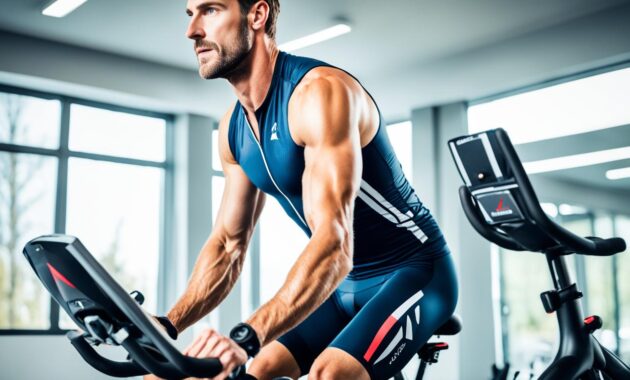
Improving your pedal stroke is essential for enhancing your cycling performance and maximizing power output. By incorporating targeted exercises and drills into your training routine, you can develop better core stability, leg strength, and pedaling technique. Here are some exercises that can help you improve your pedal stroke:
- Driving from the Hips and Core: Focus on initiating the pedal stroke from your hips and core. Engage your core muscles and drive the bike forward by applying force through your hips. This helps optimize power transfer and enhances pedal efficiency.
- Scraping Foot Through the Bottom of the Stroke: During the pedal stroke, imagine scraping your foot through the bottom of the stroke as if you’re trying to wipe something off your shoe. This motion helps you maintain a smooth and fluid pedal stroke, reducing energy wastage and enhancing overall efficiency.
- Stability and Core Engagement: To improve your pedal stroke, it’s crucial to develop stability and core strength. Incorporate exercises that target your core muscles, such as planks, Russian twists, and bicycle crunches. Strong core muscles provide a solid foundation for generating power and maintaining proper technique throughout each pedal stroke.
- Off-the-Bike Training: Off-the-bike training plays a vital role in improving your pedal stroke. Include exercises that focus on leg strength, such as squats, lunges, and leg presses. Cross-training activities like swimming and yoga can also help improve overall muscle coordination and flexibility, contributing to better pedaling technique.
- Specific Training Programs: Consider following specific training programs designed to improve pedal stroke efficiency. These programs often incorporate drills and workouts that target different aspects of the pedal stroke, helping you refine your technique and increase power output over time.
Remember to consult with a professional coach or trainer to ensure you are performing these exercises correctly and safely. Consistent practice and conditioning are key to achieving a perfect pedal stroke and unleashing your full cycling potential.
Benefits of Improving Your Pedal Stroke
By consistently working on your pedal stroke and incorporating these exercises into your training regimen, you can experience the following benefits:
- Enhanced Pedaling Efficiency: Improving your pedal stroke ensures optimal power transfer, reducing energy wastage and increasing overall efficiency.
- Increased Power Output: A refined pedal stroke allows you to generate more power with each stroke, resulting in higher speeds and improved performance.
- Improved Endurance: Efficient pedaling technique reduces fatigue and enables you to sustain higher levels of effort for longer durations, improving your endurance on the bike.
- Enhanced Injury Prevention: A proper pedal stroke minimizes stress on the joints and muscles, reducing the risk of overuse injuries and enhancing long-term joint health.
Investing time and effort in improving your pedal stroke is a worthwhile endeavor for any cyclist looking to reach their full potential. By incorporating these exercises and focusing on proper technique, you can unlock greater power, efficiency, and enjoyment during your rides.
The Importance of Varying Cadence
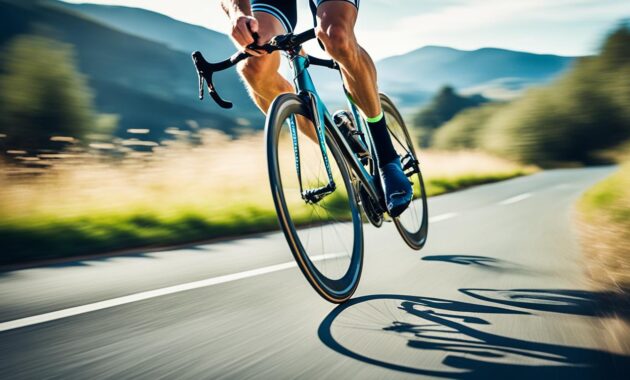
Varying your cadence during cycling is a critical aspect of optimizing your performance on the bike. By adjusting the speed at which you pedal, you can recruit different muscle fibers, ultimately improving your overall power output and efficiency.
One of the key benefits of varying your pedaling cadence is the recruitment of different muscle groups. Riding at higher cadences above 100 RPM primarily targets your endurance muscles. This continuous and rapid pedaling motion helps build your cardiovascular fitness and improves your ability to sustain effort over longer distances.
On the other hand, riding at lower cadences in the range of 60-70 RPM engages your explosive power and strength muscles. This slower pedaling motion allows for greater force production with each pedal stroke, making it ideal for powering through challenging climbs or accelerating during sprints.
To integrate varying cadences into your training routine effectively, incorporating pedaling drills can be highly beneficial. Pedaling drills involve intentionally riding at different cadences for specific durations during your workouts. This deliberate practice helps strengthen both endurance and explosive power muscle fibers, enhancing your overall cycling performance.
Sample Pedaling Drill Workout:
Warm-up: Begin with a 10-minute steady pace ride to warm up your muscles.
“30-Seconds High Cadence”: Increase your pedaling cadence to 100-110 RPM and maintain this speed for 30 seconds. Focus on maintaining smooth and controlled pedaling technique during this drill.
“30-Seconds Low Cadence”: Decrease your pedaling cadence to 60-70 RPM and maintain this speed for 30 seconds. Concentrate on generating maximum power with each pedal stroke.
Repeat the high and low cadence intervals for a total of 5-10 cycles, depending on your fitness level and training goals.
Cool-down: Finish your workout with a 10-minute easy-paced ride to gradually reduce your heart rate and allow for proper recovery.
By embracing the importance of varying your cadence, you can unleash the full potential of your pedal stroke. Experimenting with different cadences and incorporating pedaling drills into your training routine will help develop the diverse muscle groups necessary to optimize your cycling performance.
Understanding Different Pedal Types
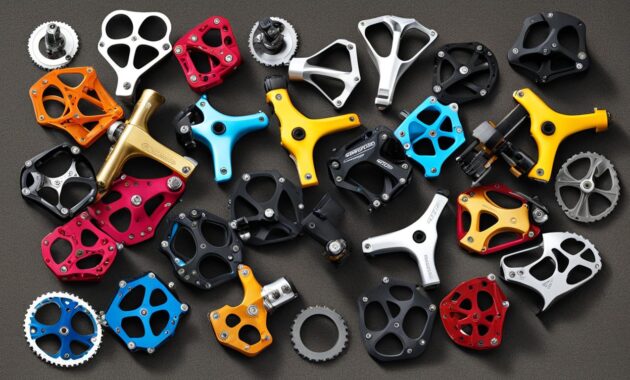
Pedals come in various types, each suited for specific purposes. It’s important to understand the differences between these pedal types to choose the right ones for your cycling needs.
Flat Pedals
Flat pedals are versatile and easy to use, making them ideal for new riders and those who need to frequently put a foot down. These pedals have a flat platform, allowing riders to place their feet on them without any specialized attachment. By using flat pedals, you have the freedom to reposition your feet as needed, providing a sense of security and control.
MTB Clipless Pedals
MTB clipless pedals provide efficient power transfer and walkability for off-road riding. These pedals have a mechanism that allows you to attach special cycling shoes to the pedal, ensuring a secure connection. The cleats on the shoes lock into the pedal, enhancing pedaling efficiency by enabling you to pull up on the pedals as well as push down. Additionally, MTB clipless pedals have a design that allows for easy walking when off the bike, making them a popular choice for mountain bikers.
Clipless Road Pedals
Clipless road pedals are favored by road cyclists for their ability to maximize power output. Similar to MTB clipless pedals, these pedals require special cycling shoes with cleats that attach to the pedal. The secure attachment allows for efficient power transfer, enabling road cyclists to generate optimal power with each pedal stroke. Road pedals are designed to be lightweight and aerodynamic, catering to the needs of riders focused on speed and performance.
By understanding the different pedal types available, you can make an informed decision based on your cycling style and preferences. Whether you opt for the versatility of flat pedals, the efficiency of MTB clipless pedals, or the power of clipless road pedals, choosing the right pedals will enhance your cycling experience and performance.
Affordable and Mid-Level Pedal Options
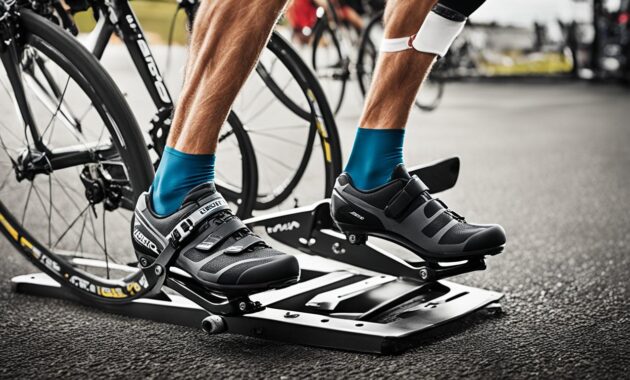
Choosing the right pedals for your bike is crucial to enhance your riding experience. Whether you’re a beginner or a seasoned cyclist, there are affordable and mid-level pedal options available that provide durability, traction, and improved performance.
Affordable pedals are a great upgrade from entry-level models as they offer better grip and control. These pedals ensure that your feet remain securely on the pedals, giving you more confidence and reducing the risk of slippage. With affordable pedals, you can enjoy a smoother and more comfortable ride, especially on rough terrains.
For cyclists who want a balance between affordability and performance, mid-level pedals are the ideal choice. These pedals are designed to withstand the demands of regular cycling and provide excellent durability. With mid-level pedals, you can enjoy a longer lifespan, reducing the need for frequent replacements.
Another advantage of mid-level pedals is their traction. These pedals are engineered with features that enhance grip, allowing you to maintain control even in wet or muddy conditions. This increased traction can greatly improve your overall cycling experience, especially during challenging terrains.
It’s important to note that affordable and mid-level pedal options cater to a wide range of cyclists, from casual riders to enthusiasts. These pedals offer improved functionality, ensuring that every pedal stroke counts and contributing to a more efficient and enjoyable ride.
Comparison of Affordable and Mid-Level Pedals
| Pedal Features | Affordable Pedals | Mid-Level Pedals |
|---|---|---|
| Durability | Good | Excellent |
| Traction | Better grip | Enhanced traction |
| Price | Affordable | Moderate |
As shown in the comparison table, both affordable and mid-level pedals offer their unique advantages. Affordable pedals provide a good balance between grip and price, making them an accessible option for many riders. On the other hand, mid-level pedals excel in terms of durability and traction, although they come at a slightly higher price point.
Ultimately, the choice between affordable and mid-level pedals depends on your budget and cycling preferences. Consider the terrain you typically ride on and the level of performance you desire. Both options will significantly enhance your pedal power, durability, and overall riding experience.
High-End Pedal Options

For riders seeking the highest performance and willing to invest more, there are high-end pedal options. These pedals are constructed using lightweight materials, resulting in weight reduction and improved performance.
High-end pedals are designed to elevate your ride and achieve maximum power transfer. The use of lightweight materials ensures a more responsive and efficient pedal stroke, allowing you to generate more power with each revolution. As a result, you can conquer challenging terrains and accelerate with ease.
These pedals are engineered with precision and attention to detail, using advanced technologies and construction methods. The combination of high-end materials, such as carbon fiber and titanium, results in pedals that are not only strong and durable but also incredibly lightweight.
With lightweight materials, you can experience reduced rotational mass, making it easier to accelerate and maintain your speed. Additionally, the reduced weight of the pedals contributes to a more balanced and responsive ride, enhancing your overall cycling performance.
| High-End Pedal Brands | Key Features |
|---|---|
| Garmin Vector 3 | – Dual-sensor design for accurate power measurement – Bluetooth and ANT+ compatibility for data tracking |
| Shimano Dura-Ace SPD-SL Pedals | – Carbon composite body for lightweight performance – Wide platform for improved power transfer |
| Look Keo Blade Carbon | – Carbon blade technology for optimal power transfer – Adjustable tension for personalized performance |
Investing in high-end pedals may come at a higher cost, but the quality and benefits they offer make them worth it for dedicated cyclists who prioritize performance and ride elevation. By choosing high-end pedals, you can elevate your cycling experience, push your limits, and unlock your full potential on the road or trail.
It’s important to note that while high-end pedals can greatly enhance your performance, they are just one piece of the puzzle. To optimize your cycling experience, ensure that your entire bike setup, including saddle, handlebars, and gears, is tailored to your needs and preferences.
Testimonial:
“Investing in high-end pedals was a game-changer for me. The lightweight materials and exceptional craftsmanship made a noticeable difference in my ride. The power transfer and responsiveness were out of this world, allowing me to conquer challenging climbs and achieve new personal records. If you’re serious about cycling performance, high-end pedals are worth every penny.”
– Jane Thompson, Professional Cyclist
The Secrets Behind the Perfect Pedal Stroke
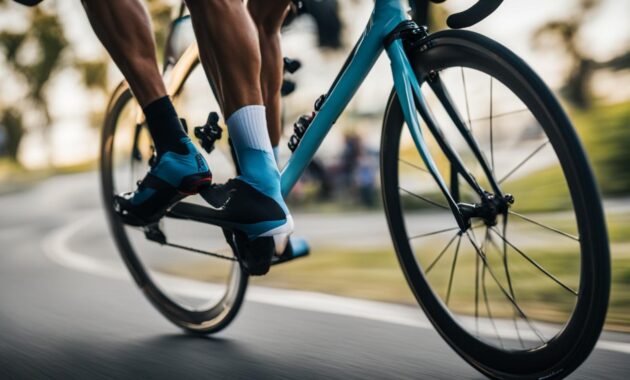
The perfect pedal stroke is essential for unlocking your cycling potential and achieving optimal performance. Understanding the mechanics of a pedal stroke, avoiding common mistakes, and incorporating targeted exercises can improve your efficiency, power output, and overall cycling experience. By mastering the pedal stroke, you can enhance your speed, endurance, and enjoyment of the sport.
Efficiency is a key factor in cycling performance. To pedal efficiently, focus on maintaining a smooth and circular motion throughout the entire pedal stroke. Avoid any jerky movements or sudden spikes in power output, as they can lead to wasted energy and decreased efficiency. Instead, aim for a consistent and even application of force on the pedals.
Technique plays a crucial role in achieving an optimal pedal stroke. Pay attention to your foot position and the alignment of your knees, hips, and ankles. Correct alignment ensures that you are utilizing the correct muscles and maximizing power transfer. To develop efficient pedal stroke techniques, consider working with a professional cycling coach or joining a group cycling class.
“The key to a powerful and efficient pedal stroke is balance, stability, and coordination.”
Incorporating targeted exercises into your training routine can significantly improve your pedal stroke. Focus on exercises that enhance core stability, leg strength, and pedaling technique. One effective exercise is single-leg pedaling, which isolates each leg and helps identify and correct any imbalances in your stroke. Additionally, off-the-bike training that targets the muscles used during cycling can also contribute to a better pedal stroke.
Commonly Asked Questions
- Q: How can I improve my pedal stroke efficiency?
- A: Focus on maintaining a smooth and circular motion, optimizing foot position, and proper alignment of the knees, hips, and ankles.
- Q: Are there specific exercises to target the pedal stroke?
- A: Yes, exercises such as single-leg pedaling and off-the-bike training can help improve pedal stroke efficiency and power output.
- Q: Can a professional coach help improve my pedal stroke?
- A: Yes, working with a professional cycling coach can provide valuable guidance and feedback on your technique and help you optimize your pedal stroke.
By applying these pedal stroke techniques and incorporating targeted exercises, you can enhance your cycling efficiency, speed, endurance, and overall performance. Don’t underestimate the impact of a well-refined pedal stroke—it can make a significant difference in your cycling journey.
Also Read : Mike’s Bike: Top-Quality Cycling Gear & Service
Conclusion
Mastering the perfect pedal stroke is a vital aspect of becoming a skilled cyclist. By focusing on proper bike fit, technique, and exercises, you can improve your efficiency, power output, and overall performance. This cycling guide has provided you with valuable insights into the secrets behind the perfect pedal stroke, helping you unlock your potential and take your riding to the next level.
Whether you’re a recreational rider or a competitive cyclist, embracing the pedal power and continuing to refine your skills can make you the best cyclist you can be. The journey to pedal perfection is an ongoing one, and by incorporating the knowledge and techniques discussed here, you can elevate your cycling experience. Keep pushing your limits, practicing diligently, and striving for improvement in every ride.
Remember, pedal perfection is not just about the physical aspect – it’s also about finding joy and fulfillment in the act of cycling. So, go ahead and embark on your cycling adventure, armed with the newfound understanding of the perfect pedal stroke. Enjoy the exhilaration of the open road, the breathtaking landscapes, and the sense of freedom that comes with every pedal revolution. Happy riding!
FAQs
Q: What are the benefits of biking for commuters?
A: Biking is a great way to stay fit, save money on transportation costs, reduce environmental impact, and beat traffic congestion.
Q: How can cyclists ensure their safety on the road?
A: Cyclists should always wear a helmet, follow traffic rules, use bike lanes when available, and make themselves visible to drivers.
Q: What are some essential maintenance tips for a mountain bike?
A: Regularly check and inflate tires, clean and lubricate the chain, inspect brakes, and do a thorough check-up of the suspension system.
Q: Is it safe to ride e-bikes in the city?
A: E-bikes can be a convenient mode of transportation in the city, but riders should be cautious of traffic, pedestrians, and follow local regulations.
Q: What rights and responsibilities do bicyclists have on the road?
A: Bicyclists have the right to share the road with vehicles and pedestrians but are also responsible for following traffic laws and respecting other road users.
Q: How can cycling be promoted in urban areas?
A: Cities can promote cycling by creating dedicated bike lanes, organizing cycling events, providing bike-sharing programs, and educating the public on the benefits of biking.
Q: What resources are available for cyclists to learn about biking laws and regulations?
A: Bicycling magazines, local transportation departments, bike advocacy groups, and online resources provide information on biking laws, safety tips, and regulations.
Source Links
- https://www.bicycling.com/training/a20021262/pedaling-mechanics/
- https://www.trekbikes.com/us/en_US/bike-pedals-guide/
- https://www.cycling-inform.com/unlock-your-cycling-potential-the-secrets-behind-the-perfect-pedal-stroke
